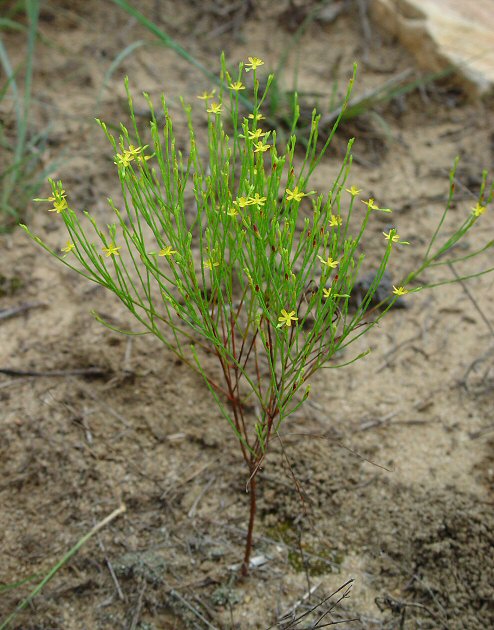Hypericum gentianoides (L.) Britton, Sterns & Poggenb.
Pineweed

Native
CC = 5
CW = 5
MOC = 46
© DETenaglia
Hypericum gentianoides (L.) Britton, Sterns & Poggenb.Pineweed | |
 |
Native CC = 5 CW = 5 MOC = 46 |
© DETenaglia |
|
Family - Hypericaceae Habit - Taprooted annual forb, usually with numerous ascending branches. Stems - Erect, to 50 cm long, angled or slightly ridged below each leaf toward the tip, green to light brown, turning orange to orangish brown with age, sometimes peeling in thin strips with age. Leaves - Opposite, strongly ascending. Blades 1-4 mm long, 0.5-1.0 mm wide, triangular to ovate, scalelike, rounded or pointed at the tip, truncate or broadly angled at the base, the margins somewhat rolled under at maturity, papery to somewhat leathery in texture, with 1 main vein visible, the surfaces with inconspicuous, minute, yellowish brown to dark green or black resinous dots (usually in a single row on each side of the midvein), the upper surface green, the undersurface green, not glaucous.
Inflorescences - Mostly solitary flowers in the leaf axils, sometimes with small, loose clusters of 3 or 5 flowers at the branch tips. Flowers - Actinomorphic. Sepals 5, 1.5-2.5 mm long, narrowly lanceolate to narrowly oblong-lanceolate, usually with inconspicuous, minute, yellowish brown to black dots, lines, and/or streaks. Petals 5, 2-4 mm long, narrowly oblong, orangish yellow to yellow, sometimes reddish-tinged, withered but usually persistent at fruiting. Stamens 5-11, the filaments sometimes irregularly spaced but usually not fused into groups. Ovary 1-locular, with parietal placentation. Styles 3, free above the base, more or less spreading, the stigmas capitate.
Fruits - Fruits 4-7 mm long, at maturity 2-3 times as long as the sepals, narrowly conical to nearly cylindrical, widest near the base, tapered to the persistent styles, triangular in cross-section. Seeds numerous, 0.4-0.8 mm long, the surface with a coarse network of ridges and pits, sometimes appearing longitudinally ribbed, light brown to dark brown.
Flowering - July - October. Habitat - Glades, upland prairies, open woods, bluffs, on acidic substrates. Origin - Native to the U.S. Lookalikes - None. Other info. - This species is found mostly in the southern half of Missouri, and also occurs throughout most of the eastern half of the continental U.S. It is a characteristic species of glades and rocky open areas having acidic soils. The plant can be easily identified by its habitat, wiry and much-branched stems, and small yellow flowers. In the fall the stems and leaves turn deep red in color. Photographs taken off Lee Rd 10, Lee County, AL., 8-24-04 (DETenaglia). |